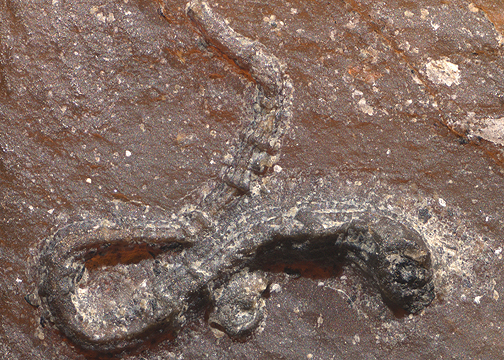Abstract
The mid-Cretaceous Burmese (Kachin) amber is renowned for its diverse inclusions and the insights they provide into ancient biodiversity. Several amberground marine animals have been hitherto reported. Here, we document a new amberground discovery: polychaete dwelling tubes, suggesting a coastal environment inhabited by multiple serpulid species. This finding provides further insights into the depositional palaeoenvironment and palaeoecology of the Burmese amber.
References
Bastida-Zavala, R. (2012) Serpula and Spiraserpula (Polychaeta, Serpulidae) from the tropical Western Atlantic and Gulf of Guinea. Zookeys, 198, 1–23. https://doi.org/10.3897/zookeys.198.3030
Berra, F. & Jadoul, F. (1996) Norian serpulid and microbial bioconstructions: implications for the platform evolution in the Lombardy Basin (Southern Alps, Italy). Facies, 35, 143–162. https://doi.org/10.1007/BF02536961
Ben-Eliahu, M.N. & ten Hove, H.A. (1992) Serpulids (Annelida: Polychaeta) along the Mediterranean coast of Israel—New population build-ups of Lessepsian migrants. Israel J. Zool., 38 (1), 35–53. https://doi.org/10.1080/00212210.1992.10688664
Cirilli, S., Iannace, A., Jadoul, F. & Zamparelli, V. (1999) Microbial-serpulid build-ups in the Norian–Rhaetian of the western Mediterranean area: ecological response of shelf margin communities to stressed environments. Terra Nova, 11, 195–202. https://doi.org/10.1046/j.1365-3121.1999.00245.x
Fischer, R., Galli Oliver, C. & Reitner, J. (1989) Skeletal structure, growth, and paleoecology of the patch reef-building polychaete worm Diplochaetetes mexicanus wilson, 1986 from the Oligocene of Baja California (Mexico). Geobios, 22, 761–775. https://doi.org/10.1016/S0016-6995(89)80071-3
Fischer, R., Pernet, B. & Reitner, J. (2000) Organomineralization of cirratulid tubes-fossil and Recent examples. Facies, 42, 35–50. https://doi.org/10.1007/BF02562565
Flügel, E., Flügel-Kahler, E., Martin, J.M. & Martin-Algarra, A. (1984) Middle Triassic reefs from Southern Spain. Facies, 11, 173–218. https://doi.org/10.1007/BF02536910
Ippolitov, A.P. (2010) Serpulid (Annelida, Polychaeta) evolution and ecological diversification patterns during Middle–Late Jurassic. Earth Science Frontiers, 17, 207–208.
Kupriyanova, E.K., Vinn, O., Taylor, P.D., Schopf, J.W., Kudryavtsev, A.B. & BaileyBrock, J.H. (2014) Serpulids living deep: Calcareous tubeworms beyond the abyss. Deep sea research part I: oceanographic research papers, 90, 91–104. https://doi.org/10.1016/j.dsr.2014.04.006
Mao, Y.Y., Liang, K., Su, Y.T., Li, J.G., Rao, X., Zhang, H., Xia, F.Y., Fu, Y.Z, Cai, C.Y. & Huang, D.Y. (2018) Various amberground marine animals on Burmese amber with discussions on its age. Palaeoentomology, 1 (1), 091–103. https://doi.org/10.11646/palaeoentomology.1.1.11
Perkins, T.H. (1991) Calcisabella piloseta, a new genus and species of Sabellinae (Polychaeta: Sabellidae). Bulletin of Marine Science, 48, 261–267.
Ross, A.J. (2019) Burmese (Myanmar) amber checklist and bibliography 2018. Palaeoentomology, 2 (1), 22–84. https://doi.org/10.11646/palaeoentomology.2.1.5
Ross, A.J. (2024) Complete checklist of Burmese (Myanmar) amber taxa 2023. Mesozoic, 1 (1), 21–57. https://doi.org/10.11646/mesozoic.1.1.4
Sanfilippo, R., Rosso, A., Guido, A. & Gerovasileiou V. (2017) Serpulid communities from two marine caves in the Aegean Sea, eastern Mediterranean. Journal of the Marine Biological Association of the United Kingdom, 97 (5), 1059–1068. https://doi.org/10.1017/S0025315417000297
Rouse, G.W. & Pleijel, F. (2001) Polychaetes. Oxford University Press, Oxford, 354 pp.
Rousset, V., Rouse, G.W., Siddall, M.E., Tillier, A. & Pleijel, F. (2004) The phylogenetic position of Siboglinidae (Annelida), inferred from 18S rRNA, 28S rRNA, and morphological data. Cladistics, 20, 518–533. https://doi.org/10.1111/j.1096-0031.2004.00039.x
Sanfilippo, R., Rosso, A., Reitano, A. & Insacco, G. (2017) First record of sabellid and serpulid polychaetes from the Permian of Sicily. Acta Palaeontologica Polonica, 62, 25–38. https://doi.org/10.4202/app.00288.2016
Sanfilippo, R., Rosso, A., Reitano, A., Viola, A. & Insacco, G. (2018) New serpulid polychaetes from the Permian of western Sicily. Acta Palaeontologica Polonica, 63, 579–584. https://doi.org/10.4202/app.00448.2017
Stiller, F. (2000) Polychaeta (Annelida) from the Upper Anisian (Middle Triassic) of Qingyan, south-western China. Neues Jahrbuch für Geologie und Paläontologie, 217, 245–266. https://doi.org/10.1127/njgpa/217/2000/245
Senowbari-Daryan, B., Link, M. & Işintek, I. (2007) Filograna minor nov. sp. (Worm Tube) from the Middle Triassic (Anisian) reef boulders of the Karaburun Peninsula, Western Turkey. Turkish Journal of Earth Sciences, 16, 1–9.
ten Hove, H.A. & Kupriyanova, E.K. (2009) Taxonomy of Serpulidae (Annelida, Polychaeta): the state of affairs. Zootaxa, 2036 (1), 1–126. https://doi.org/10.11646/zootaxa.2036.1.1
Vinn, O., Hove, H.A.ten & Mutvei, H. (2008) On the tube ultrastructure and origin of calcification in sabellids. Palaeontology, 51, 295–301. https://doi.org/10.1111/j.1475-4983.2008.00763.x
Zherikhin, V. V. & Ross, A. J. (2000) A review of the history, geology and age of Burmese amber (Burmite). Bulletin of the Natural History Museum, 56, 3–10.
Ziegler, V. & Michalík, J. (1980) Late Triassic serpulids (Annelida, Polychaetia, Sedentarida) in the Western Carpathians. Geologicky Zborník-Geologica Carpathi


